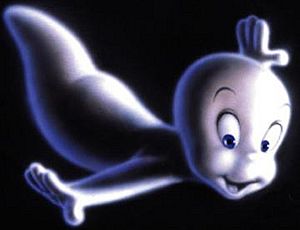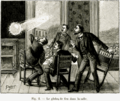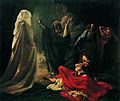Ghost facts for kids
A ghost is often described as the spirit of a dead person or animal. Many people believe these spirits can appear to living people. In stories and folklore, ghosts can look very different. Some are invisible, while others might be see-through or look just like real people.
Contents
What are Ghosts?
In ghostlore, which is the study of ghost stories, people describe ghosts in many ways. Some say ghosts are an invisible presence. Others describe them as wispy, barely visible shapes. Sometimes, they are even said to look like real, living forms.
People use many different words for ghosts. Some of these words include apparition, haunt, phantom, poltergeist, shade, specter or spectre, spirit, spook, and wraith. A poltergeist, for example, is a type of ghost said to cause physical disturbances, like making noises or moving objects.
Do Ghosts Really Exist?
Most scientists agree that there is no real proof that ghosts exist. They often look for natural explanations for strange events that people might think are caused by ghosts. For example, some strange lights or sounds could be explained by weather or animals.
Even though scientists don't have proof, ghosts are a big part of many cultures and stories. Kids often dress up as ghosts for Halloween fun!
Ghosts in Stories and Art
Ghosts have appeared in stories, plays, and art for thousands of years. Ancient cultures, like the Greeks, had stories about spirits of the dead. For example, in the famous play Hamlet by William Shakespeare, the main character meets the ghost of his father. This ghost wears armor, which was a common way to show old or important ghosts in plays from that time.
In Japan, ghosts are called Yūrei. These spirits often have specific looks, like long black hair and white clothes. Many cultures around the world have their own unique ghost stories and beliefs.
Images for kids
-
Union Cemetery in Easton, Connecticut is home to the legend of the White Lady.
-
Apulian red-figure bell krater depicting the ghost of Clytemnestra waking the Erinyes, date unknown
-
Athenodorus and the Ghost, by Henry Justice Ford, c.1900
-
"Hamlet and his father's ghost" by Henry Fuseli (1796 drawing). The ghost is wearing stylized plate armor in 17th-century style, including a morion type helmet and tassets. Depicting ghosts as wearing armor, to suggest a sense of antiquity, was common in Elizabethan theater.
-
A 1901 depiction of ball lightning
-
Macbeth Seeing the Ghost of Banquo by Théodore Chassériau
-
Utagawa Kuniyoshi, The Ghosts, c. 1850
See also
 In Spanish: Fantasma para niños
In Spanish: Fantasma para niños














